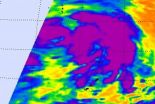A complete solution for oil-spill cleanup
2012-10-04
(Press-News.org) Scientists are describing what may be a "complete solution" to cleaning up oil spills — a superabsorbent material that sops up 40 times its own weight in oil and then can be shipped to an oil refinery and processed to recover the oil. Their article on the material appears in ACS' journal Energy & Fuels.
T. C. Mike Chung and Xuepei Yuan point out that current methods for coping with oil spills like the 2010 Deepwater Horizon disaster are low-tech, decades-old and have many disadvantages. Corncobs, straw and other absorbents, for instance, can hold only about 5 times their own weight and pick up water, as well as oil. Those materials then become industrial waste that must be disposed of in special landfills or burned.
Their solution is a polymer material that transforms an oil spill into a soft, solid oil-containing gel. One pound of the material can recover about 5 gallons of crude oil. The gel is strong enough to be collected and transported. Then, it can be converted to a liquid and refined like regular crude oil. That oil would be worth $15 when crude oil sells for $100 a barrel. "Overall, this cost-effective new polyolefin oil-SAP technology shall dramatically reduce the environmental impacts from oil spills and help recover one of our most precious natural resources," the authors said.
INFORMATION:The authors acknowledge funding from the National Science Foundation and Ben Franklin Technology Partners.
The American Chemical Society is a nonprofit organization chartered by the U.S. Congress. With more than 164,000 members, ACS is the world's largest scientific society and a global leader in providing access to chemistry-related research through its multiple databases, peer-reviewed journals and scientific conferences. Its main offices are in Washington, D.C., and Columbus, Ohio.
To automatically receive news releases from the American Chemical Society, contact newsroom@acs.org.
END
ELSE PRESS RELEASES FROM THIS DATE:
2012-10-04
Billions of people around the world today will unknowingly perform a chemical reaction first reported 100 years ago. And the centennial of the Maillard reaction — which gives delightful flavor to foods ranging from grilled meat to baked bread to coffee — is the topic of a fascinating article in the current edition of Chemical & Engineering News. C&EN is the weekly news magazine of the American Chemical Society, the world's largest scientific society.
Sarah Everts, C&EN senior editor, explains in the article that French chemist Louis-Camille Maillard took a first stab ...
2012-10-04
Certificate of Need, a form of state government regulation designed to keep mortality rates and health care costs down, appears to do neither for heart bypass surgery, according to a health economics researcher at Rice University and Baylor College of Medicine (BCM). Her findings are reported in an article appearing in today's online edition of the journal Medical Care Research and Review.
Lead author Vivian Ho, the chair in health economics at Rice University's Baker Institute for Public Policy and a professor of medicine at BCM, found that states that removed Certificate ...
2012-10-04
CAMBRIDGE, MA -- The colorful leaves piling up in your backyard this fall can be thought of as natural stores of carbon. In the springtime, leaves soak up carbon dioxide from the atmosphere, converting the gas into organic carbon compounds. Come autumn, trees shed their leaves, leaving them to decompose in the soil as they are eaten by microbes. Over time, decaying leaves release carbon back into the atmosphere as carbon dioxide.
In fact, the natural decay of organic carbon contributes more than 90 percent of the yearly carbon dioxide released into Earth's atmosphere ...
2012-10-04
After a series of Philadelphia hospitals started closing their maternity units in 1997, infant mortality rates increased by nearly 50 percent over the next three years. The mortality rates subsequently leveled off to the same rate as before the closures, but pediatric researchers say their results underscore the need for careful oversight and planning by public health agencies in communities experiencing serious reductions in obstetric services.
Between 1997 and 2007, 9 of 19 obstetric units closed in Philadelphia, resulting in 40 percent fewer obstetric beds. Other research ...
2012-10-04
A simple new test, in which the patient swallows a string, can monitor treatment of eosinophilic esophagitis as effectively as an invasive, expensive and uncomfortable procedure that risks complications, particularly in children.
Researchers from the University of Illinois at Chicago College of Medicine, working in collaboration with clinician-investigators at the University of Colorado Denver/Children's Hospital Colorado and Lurie Children's Hospital in Chicago, reported their findings in a study published recently online in the journal Gut.
Eosinophilic esophagitis, ...
2012-10-04
MAYWOOD, Ill. – Gender-specific group therapy is effective for treating depressed women with Type 2 diabetes, according to a study published in the latest issue of the Annals of Behavioral Medicine and funded by the National Institute of Nursing Research. Evidence suggests that antidepressants may disrupt blood-sugar control and can be associated with increased weight gain; therefore, other treatment options are needed for depression.
"Using antidepressants to treat depression, although important, can be associated with side effects that make compliance an issue for people ...
2012-10-04
Amsterdam, The Netherlands, October 3, 2012 – Milk consumption has been linked to improved health, with decreased risks of diabetes, metabolic syndrome, and colon cancer. A group of scientists in Sweden found that lactoferricin4-14 (Lfcin4-14), a milk protein with known health effects, significantly reduces the growth rate of colon cancer cells over time by prolonging the period of the cell cycle before chromosomes are replicated. In a new study, investigators report that treatment with Lfcin4-14 reduced DNA damage in colon cancer cells exposed to ultraviolet (UV) light. ...
2012-10-04
STANFORD, Calif. — Not everyone is able to be hypnotized, and new research from the Stanford University School of Medicine shows how the brains of such people differ from those who can easily be.
The study, published in the October issue of Archives of General Psychiatry, uses data from functional and structural magnetic resonance imaging to identify how the areas of the brain associated with executive control and attention tend to have less activity in people who cannot be put into a hypnotic trance.
"There's never been a brain signature of being hypnotized, and we're ...
2012-10-04
The fifteenth tropical depression of the Atlantic Ocean hurricane season was born on Oct. 3 an NASA's Terra satellite captured an image of it as it came to be.
NASA's Terra satellite passed over newborn Tropical Depression 15 on Oct. 3 at 8:52 a.m. EDT in the central Atlantic Ocean and the Moderate Resolution Imaging Spectroradiometer (MODIS) instrument captured an image of the storm. Shortly after the image was created, forecasters at the National Hurricane Center looking at the MODIS and other satellite data determined that the low pressure area had become a depression.
On ...
2012-10-04
NASA's Aqua satellite took an infrared "picture" of Tropical Storm Maliksi in the western North Pacific Ocean and identified the strongest part of the storm being east of its center.
On Oct. 3 at 1500 UTC (11 a.m. EDT), Tropical storm Maliksi had maximum sustained winds of 45 knots (51.7 mph/83.3 kph). It was located about 470 nautical miles (541 miles/870.4 km) south-southeast of Tokyo, Japan, near 29.4 North and 143.1 East. Maliksi was speeding to the north-northeast at 21 knots (24.1 mph/38.8 kph).
The Atmospheric Infrared Sounder (AIRS) instrument that flies ...
LAST 30 PRESS RELEASES:
[Press-News.org] A complete solution for oil-spill cleanup

